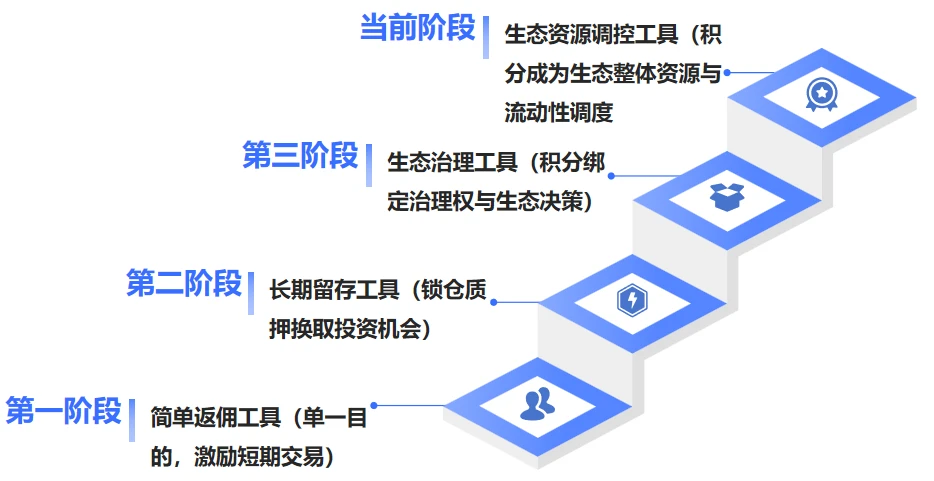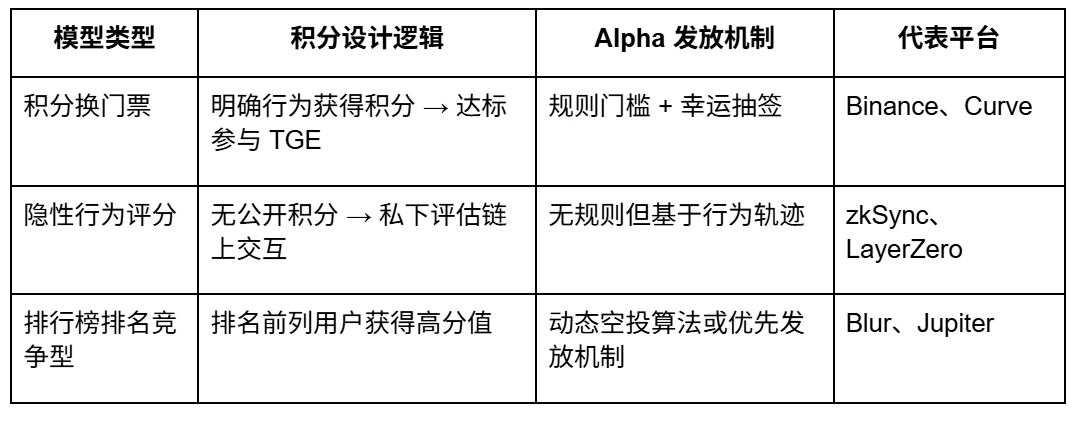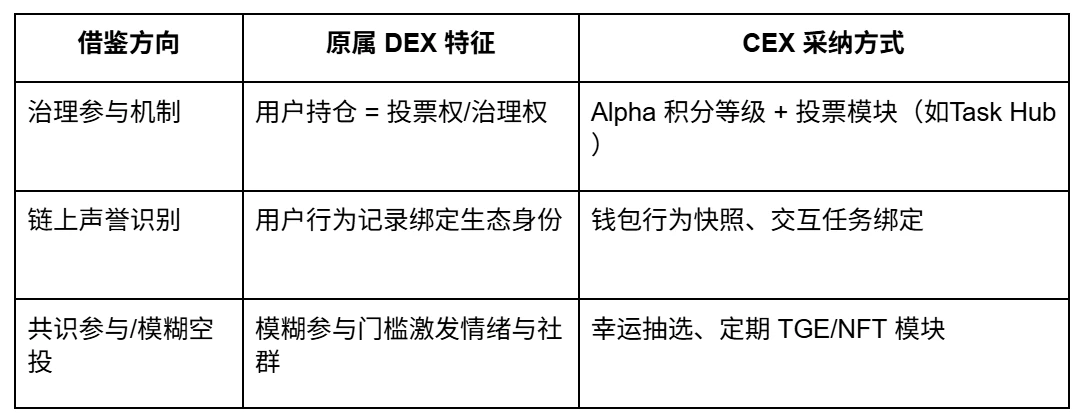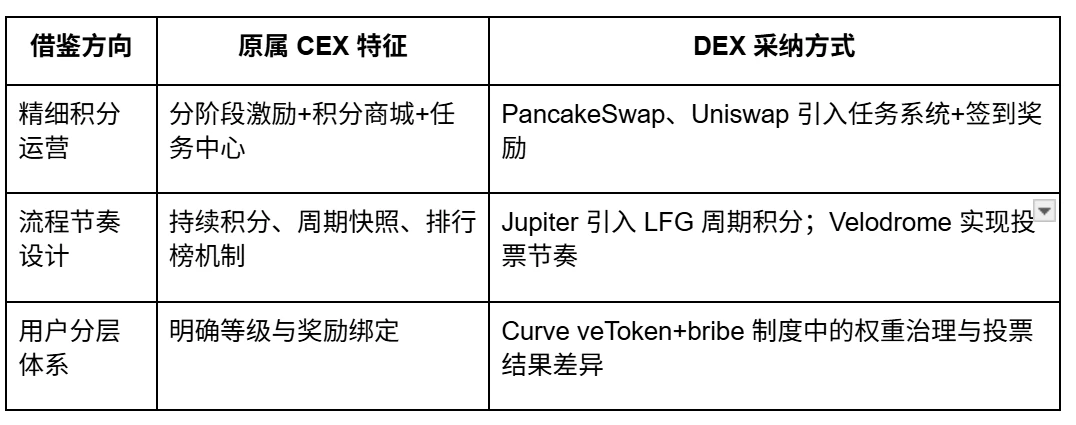Introduction: Why are we so obsessed with “integral” and “Alpha”?
I don’t know since when, but we seem to have become particularly sensitive to “integral” and “Alpha”.
The first thing we do when we open an exchange or DEX is no longer to find the next coin that can double, but to check whether there are any changes in the ranking list or any new Alpha airdrop rule updates.
We began to carefully maintain our on-chain behavior records - even though we didnt really know what the points would eventually be exchanged for, and we werent sure how the Alpha airdrop would be distributed. But we still enjoyed scoring and interacting because we always felt that they would bring unexpected surprises one day.
Gradually, we realized that the so-called points are no longer just transaction incentives, but strategic levers for platforms to dispatch assets and control user attention; and Alpha is no longer just a vague empty investment qualification, it is becoming the strongest emotional driver in an ecological governance mechanism.
In the past five years, from CEXs such as Binance, OKX, and Bybit to DEXs such as Uniswap, Curve, and zkSync, the gameplay of points and Alpha has continued to evolve: from the initial transaction rebates to todays ecological mechanism with community governance, resource regulation, and traffic screening as the core.
This user growth game that seems to be composed of Alpha and points is actually reshaping the relationship between users, platforms and ecosystems, and each of us has already been in this game.
1. The essential evolution of the points mechanism: from a rebate tool to an ecological scheduling system
In the early crypto ecosystem, whether CEX or DEX, points played a very simple role: to increase user trading volume.
The initial trading points were very simple and crude. Exchanges such as Bitstamp and Bitfinex only provided different levels of rebates or rate discounts based on the volume of transactions. This design similar to points is intuitive and effective. Users can clearly see the direct economic benefits corresponding to each transaction. It is similar to points in form, and users can directly see the economic benefits brought by each transaction. But its flaws are also obvious: it cannot retain long-term users, let alone form real community stickiness. Users are more like profit-seeking traffic rather than co-builders.
Alpha is almost non-existent at this stage, or is just a vague early investment opportunity that fails to truly become a driving force for user growth.
1. From “trading rebates” to “early investment tickets”
After 2017, with the emergence of Binance Launchpad, CEX linked points with opportunities for the first time: users obtained points through staking or holding positions in exchange for the qualification to participate in the IDO of high-quality projects.
This design changes the rules of the game: points are no longer just used to reduce transaction fees, but become a stepping stone to approach Alpha projects - you need to accumulate assets and stay active in order to exchange for a ticket to the next wave of potential skyrocketing.
Later platforms such as OKX Jumpstart and Bybit Launchpad copied this mechanism. The points game has since entered the opportunity binding stage: it is no longer about giving rewards but screening people.
2. From “screening people” to “empowering governance”
The DEX ecosystem, which is developing in parallel, reshapes the meaning of points in a more radical way. Uniswaps UNI airdrop in 2020 is a real breakthrough in the concepts of points and Alpha. It is not a simple rebate, but an active incentive + governance mechanism based on past on-chain behaviors. Users no longer just receive short-term rewards, but directly become participants in protocol governance. Behind the points is the governance and decision-making power of the on-chain community.
This transformation clarified the strategic connotation of points: from a simple transaction-driven one to a core tool for ecological governance and community participation.
After 2021, this trend has further deepened. The veToken points model launched by Curve clearly allows points to directly determine governance rights and ecological income distribution; and the new generation of DEX represented by Raydium embeds points into the core process of project launch and ecological launch. At this time, points are no longer an accessory of the platform, but a basic tool for project launch, community governance, and resource allocation in the Web3 ecosystem.
When we look back at the history of the integration mechanism, we can clearly see the evolution path of its core:

Image source: Nomos Lab compiled based on public information
Nowadays, both CEX and DEX are strategically designing points rules to regulate user attention, asset flow direction, and even the development trend of the entire ecosystem. The competition of the points mechanism is no longer a simple preferential game, but a real ecological war.
From simple transaction incentives to deep-level ecological strategic weapons, the evolution of points shows the profound changes in Web3 user growth strategies. This change is not only the result of user demand, but also the inevitable result of the escalating competition and game between platforms.
II. Alienation and Co-evolution of Alpha Mechanisms: From Fuzzy Expectations to Ecological Drivers
If points are the rules and order set by the platform, then Alpha is the emotional fuel for user participation.
Points often have clear ways to obtain and redeem points, but Alpha is driven by a vague but strong expectation, motivating users to remain active in the ecosystem, even if no rewards are stated at all.
It is not always tied to the points mechanism, and sometimes even exists outside the entire incentive system, but it often creates the strongest desire to participate and becomes the core non-institutional force in platform growth.
1. The psychological nature of Alpha: ambiguity creates enthusiasm for participation
The charm of Alpha lies in uncertainty.
Because users don’t know whether there will be an Alpha airdrop, when it will come, and how to share it, they are more likely to actively participate, interact, and keep their assets active under the expectation of “maybe”. This is a typical psychological game: vague hopes are more attractive than clear rules.
Blur is the most typical example. Although its early airdrop points mechanism had a ranking list, there were no clear redemption rules. Users were still willing to place orders, interact, and create trading volume crazily because they believed: as long as I am active, I may be rewarded.
This emotional drive constitutes the underlying power of Alpha.
2. Three mainstream Alpha models and their evolutionary logic
(1) Narrative-driven Alpha: Drive participation through emotional consensus
Representative projects: zkSync, StarkNet, Scroll
Mechanism features: No points system, only relying on rumors of possible airdrops to stimulate user on-chain interaction
User behavior: Interacting with the entire ecosystem, registering for all projects, extremely scattered but highly persistent behavior
(2) Points-linked Alpha: Binding expectations with rules
Representative projects: Binance Alpha Points, Curve veCRV
Mechanism features: Alpha is clearly bound to points, and points can be used to redeem TGE quota or airdrop qualifications
User behavior: Actions centered around points tasks, high concentration of assets and behaviors, and high competition intensity
(3) Behavior-capturing Alpha: Irregular but highly effective
Representative projects: LayerZero, Blur
Mechanism features: There is no formal points system, but user behavior data is secretly recorded and affects airdrop qualifications
User behavior: self-design behavior trajectory around interaction, but the input-output ratio cannot be determined
3. Alpha’s gaming risks: overstimulation and behavioral alienation
Although the ambiguity of Alpha can stimulate enthusiasm, it can also easily create problems such as short-term arbitrage and invalid volume manipulation.
Blur’s initial order-brushing problem, zkSync’s large number of low-quality interactions, and LayerZero’s accusation of over-guiding “interaction farms” all expose a core problem:
When Alpha is no longer scarce and becomes the norm of “existing as long as there is interaction”, it loses its screening value and instead pollutes the ecosystem.
Therefore, the platform began to try to use the combination mechanism of points + Alpha to carry out more refined control.
4. Alpha and Integral: A Hybrid Mechanism of Co-evolution
A single mechanism is no longer sufficient to meet the needs of ecological management. Therefore, platforms began to explore a dual-track drive:
Mechanism Advantages Risk Optimal Mode of Action Points Clear rules, easy to layer incentives Easy to be swiped, forming involution As the basic structure and screening threshold Alpha stimulates enthusiasm and strengthens user participation Expectations are unstable, inducing excessive interactions As an additional reward and emotional driver
The goals of the hybrid mechanism are to:
Use points to regulate behavioral paths and avoid systemic abuse;
Use Alpha to “create vague expectations” and stimulate long-term enthusiasm for participation.
The Binance Alpha Points model uses this strategy:
Set points earning rules and consumption thresholds (institutionalized control);
Introducing lucky mechanics and special conditions (emotional draw);
And in each Alpha project, the release rhythm and difficulty are controlled to achieve the dual goals of traffic management and user screening.
5. Alpha’s new function: becoming a “pledge” for on-chain narrative and ecological identity
Alphas evolutionary path is gradually changing from reward to symbol of status.
In ecosystems such as zkSync and LayerZero, users do not just interact for short-term airdrops, but want to be identified as “ecosystem co-builders” or “long-term participants.” Alpha begins to become an indirect credential for on-chain reputation and governance rights.
Blur launches a points consumption mechanism after airdrop: Encourage long-term activity rather than a one-time ranking rush
Binance Alpha sets points retention threshold and random conditions: screening loyal rather than arbitrage users
LayerZero begins identifying “real interaction paths” and setting up behavioral anti-cheating systems
These changes point to a common trend:
Alpha is becoming the most differentiated and symbolic value distribution logic in the on-chain ecosystem.
3. Points × Alpha - User Control System under Dual-Track Drive
The growth mechanism of the Web3 world is entering a dual-track drive stage: the institutional points system and the vague Alpha rewards are beginning to be consciously combined to form a strategic tool that runs through user acquisition, behavior guidance, asset sedimentation and rhythm management.
In the past, points and Alpha were two parallel worlds: one was a participation structure with clear rules and quantifiable information; the other was a vague and uncertain expectation that mobilized the subjective imagination of users. But today, they are no longer separated, but leverage each other to build a new user behavior operating system.
Binance was the first to realize this. In its Alpha Points mechanism, the rules for obtaining points are designed to be extremely sophisticated: users gain points through trading, holding positions, and participating in activities; at the same time, the system sets different levels of qualification thresholds to exchange for priority subscription rights or airdrop qualifications for specific TGE projects. However, what really drives users to score points crazily is not the direct use of these points, but the suspenseful Alpha behind it - that is, if you scoop up enough points, you may get an airdrop, but you may also miss it.
This fuzzy boundary design has greatly stimulated users enthusiasm for participation. For example, in the DOOD airdrop, users with a score of 168 or above are directly qualified, while users with a score of 129 to 167 need to rely on the UID tail number to draw a lottery. This subtle fuzzy interval allows a large number of users to actively increase interaction and improve their scores to avoid falling into the risk zone of being marginalized.
The core of this mechanism is that points provide structure, while Alpha provides suspense; points are what I have done, while Alpha is maybe there will be results; points are bound to rules, while Alpha mobilizes psychology. When the two are combined, the platform gains multiple regulatory capabilities over user attention, time, behavior, and asset flow paths.

Image source: Nomos Lab compiled based on public information
This structure not only optimizes the logic of user stratification and screening, but also greatly improves the platforms ability to control the rhythm within the ecosystem. Take Blur as an example. In its early days, it did not give any points redemption rules, but through means such as point rankings and behavior-linked scoring systems, it successfully created an emotional guidance of efforts will be seen, thereby promoting users continuous, high-frequency, and high-cost participation.
This approach of using fuzzy alpha as the core of incentives is actually a deep exploitation of user psychology: when the reward rules are not transparent, users will invest more, because everyone believes that maybe I can be selected. The existence of points builds a positive feedback framework for this ambiguity, I am doing the right thing:
Points control behavior path: clarify incentive rules and guide users to lock assets and participate in the long term;
Alpha provides emotional drive: creating uncertainty, motivating users to brush their scores and increase stickiness;
Fusion point: Use the combination of points snapshot + Alpha airdrop + consumption mechanism to regulate the rhythm and ecological load.
Eventually, user behavior also changes. They no longer act just to exchange for rewards, but to leave a trace and be recognized by the system. They build a points identity on the platform and bet on the realization of Alpha in the future. This participation means candidate mechanism transforms users from short-term actors to long-term asset co-builders.
This is exactly the silent binding that the platform hopes for.
4. The boundary of integration - the interpenetration of mechanisms and the reconstruction of competition between CEX and DEX
As the dual-track mechanism of Alpha × Points matures, another essential trend begins to surface: the boundaries between CEX and DEX mechanisms are blurring rapidly, and they are learning from each other and gradually merging. In the past, we viewed the two as opposing paradigms of centralization vs. decentralization, but now, they are moving towards the same goal - building a more stable user participation system and ecological collaboration mechanism.
First, the governance concept of CEX is leaning towards DEX. Platforms such as Binance, OKX, and Gate are no longer satisfied with the traditional task center + rebate points design, and have begun to introduce concepts such as on-chain behavior snapshots, on-chain wallet binding, and task structure stratification, and build user levels and points growth paths through these on-chain interaction traces. For example, Binance introduced the Web3 wallet binding + on-chain task participation rule in Alpha Points, which is essentially to identify trusted users through on-chain behavior and create a DEX-style reputation distribution.
At the same time, these platforms have gradually added light governance modules, such as user voting for listing (such as Gate Startup) and event voting (such as the OKX voting list), and began to build a path of user consensus → behavior value, which essentially borrowed the governance participation structure of DEX.

Image source: Nomos Lab compiled based on public information
At the same time, DEX is also quietly moving closer to CEX. New generation DEXs such as Uniswap, PancakeSwap, Jupiter, and Velodrome have begun to introduce institutionalized operation modules such as point systems, task structures, phased airdrops, ranking mechanisms, and periodic liquidations.
Jupiters LFG system is a typical ranking + points reset + cycle CEX operation model. Velodrome uses veNFT and bribe mechanisms to implement a combination strategy of governance voting and incentive distribution, building a programmable points path of user behavior + governance incentives. Uniswap is promoting the cross-protocol structure of on-chain identity + multi-chain points and continuously evolving in operational accuracy.

Image source: Nomos Lab compiled based on public information
More importantly, user behavior is also changing with the integration of the two types of platforms.
They no longer simply choose a platform but choose a mechanism: whether there are reasonable points rules, whether vague but real Alpha rewards are provided, and whether there is an identifiable identity track. The unit of platform competition is no longer number of users but mechanism design ability - whoever can build a smoother incentive structure and accumulate higher-quality user paths will have a better chance of winning the future ecological dominance.
Points and Alpha are becoming the mechanism language in this competition.
The battle for traffic in the past is transforming into a battle for mechanism design, and platform governance, community control, and user stickiness are moving towards the next stage of deep structuring through this integration.
Chapter 5: After the points, the battle of mechanisms has just begun
We used to think that points were a promotional tool, giving users some benefits, attracting new customers, and stabilizing transaction volume, and that was mission accomplished. But looking back now, this understanding was too shallow.
In todays Web3 world, the gameplay of points and Alpha is no longer a superficial incentive structure, but has become an interface for the game of cognition and power between platforms and users.
On the one hand, the platform uses a points system to carefully set the users behavioral trajectory - what is worth doing, when to do it, and how much is considered qualified; on the other hand, it uses a vague Alpha mechanism to create an expectation of maybe, continuously arousing your desire to participate.
This mechanism is very clever because it does not require you to know what you will get at the moment, it only requires you to believe that it is worth staying.
And just as this narrative logic was gradually taking shape, new changes began to brew.
We are standing at a crossroads of mechanism fusion → mechanism transition. The next game will no longer be just about what you did, but what traces you left in whose system.
In the future, points will probably no longer be as simple as trading volume × weight, but will be composed of multiple variables:
Which chains have you interacted with?
How many ecosystems have you participated in the governance of?
Do you have a complete and coherent set of on-chain behavior traces?
Are you doing a ranking-boosting task, or are you actually participating?
In other words, points are not just evidence of behavior, but a way for the ecosystem to understand your value.
And this understanding will no longer be limited to a single platform.
We can already see some signs:
The zkSync airdrop introduced the average asset retention time when calculating interactions; LayerZeros points system has long secretly recorded the chains and depths you participate in; on-chain identity protocols such as Sismo and Gitcoin Passport have begun to be adopted on multiple platforms, becoming your identity card for whether you are a real user.
Perhaps in the near future, points from different platforms will no longer compete with each other, but will form a trust network that is mutually recognized across ecosystems: if you have interacted with LayerZero, zkSync will lower the threshold for you; if you have participated in the governance of a DAO, Blur may be willing to directly whitelist you.
At that time, what we are facing is not how many points we get, but how the entire Web3 sees me.
On the other side, the platform also began to become nervous.
While ambiguity leads to high participation, regulatory uncertainty is also approaching:
Are points considered assets? Does Alpha constitute disguised financing? If the purpose of a points system is to eventually airdrop tokens to users, does it need to publicly disclose the distribution logic? Are there any compliance risks involved?
As a result, you will see that more and more platforms are becoming vague and restrained: they do not give you a very clear formula, do not directly tell you what you can exchange for a certain number of points, everything is just a reference, and everything is subject to official subsequent notification.
It seems to be keeping secrets, but in fact it is avoiding responsibility.
The end point of this ambiguity war is likely to be: users become smarter and platforms become more cautious.
Therefore, the truly effective mechanism will no longer be stimulating interaction, but designing a participation structure that makes users willing to stay and worth being recognized. It is not about getting people to score points, but about being willing to build together.
This mechanism is not just a means of operation, but the ecological order itself.
In conclusion: You are not just swiping points, but who you are
Points may seem like rewards, but they are actually records of your participation.
Alpha may look like an airdrop, but it is actually a signal that “you are seen”.
Looking back at the entire evolution process, from Bitfinex’s rebate system, to Binance’s Launchpad, from Uniswap’s UNI airdrop, to Curve’s veToken decision-making power, to LayerZero, Jupiter, and zkSync’s user identification algorithms, we can see clearly:
Users stay not because of incentives, but because of mechanism recognition.
And we have long evolved from hair-pulling party to candidates.
We participate in interactions not for short-term gains, but to build an identity, an image that can be seen by the ecosystem.
What we are betting on is not just the points, but the kind of people we are willing to become. What we are betting on is not just Alpha, but our belief that a certain mechanism is worth participating in and building together.
The battlefield between platforms has also changed from who has more airdrops to whose system can retain people.
From competition for traffic to competition for structure.
From incentive game to identity construction.
From points game to order design.
We will eventually forget how many points there are and what Alpha gave.
But we will remember: which platform once truly saw me.
References
CoinMarketCap. (2024). The evolution of decentralized exchanges.
GlobeNewswire. (2024, September 17). Bybit Web3 makes WSOT debut: DEX Wave featuring over 100 DeFi partners in Web3s first idol competition.
NFTEvening. (2025, April). Understanding Binance Alpha Points: A guide to earn rewards.
ODaily. (2025, February). DEX points incentives: Opportunities and challenges in Web3.
ODaily. (2025, March). Web3 points wars: Trends and user engagement strategies.
ODaily. (2025, April). Binance Alpha ecosystem: TGEs and points-driven growth.
Panews. (2024, October). Bybit WSOT DEX Wave: Voting mechanisms and liquidity boost.
Panews. (2024, December). OKX Jumpstart: Staking mechanisms and accessibility challenges.
Panews. (2025, January). Gate.io Startup and task center: Points for new users.
Panews. (2025, March). Web3 points wars: A comparative analysis of major platforms.
Panews. (2025, April). Binance Alpha Points: Mechanics and market impact.
TheBlockBeats. (2024, November). Uniswaps multi-chain points plan: Scaling DeFi incentives.
TheBlockBeats. (2025, February). PancakeSwaps voting points: Governance and resource allocation.
TheBlockBeats. (2025, April). Binance TGE airdrops: Attracting investors in 2025.
Thirdweb. (2024). Web3 loyalty programs: NFTs and points interoperability.










